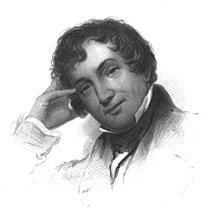The Alhambra
The Alhambra (most widely used English title: Tales of the Alhambra ), also published in other German editions under the titles Tales of the Alhambra, Tales from the Alhambra or Legends from the Alhambra , is a collection of short prose pieces written by the American writer Washington Irving wrote in 1829.
content

The collection of stories is embedded in a framework story in which the author describes his journey through Spain to Andalusia and gives a general description of the country and its people. The main part of the book consists of around thirty stories (depending on the edition) about the Alhambra , the city castle of the last Moorish rulers in Al-Andalus . The stories take place to a lesser extent at the time of the Nasrid rulers , but the greater part in post-Moorish times, when the Alhambra was administered by Christian governors as the property of the Spanish kings and was increasingly abandoned to decay.
History of origin and impact
Washington Irving came to Spain in 1826 on an extensive trip to Europe. As a result of extensive research into the sources of both Spanish history and Arabic culture, Irving published a biography of Christopher Columbus in 1828 and a year later the fictitious chronicle of the conquest of Granada . In 1829 he then traveled to Granada , where he lived in the Alhambra for four months and wrote down the narratives of the collection. His stay ended when he was called to London as secretary of the US Embassy , a position Irving held until 1832.
The first edition was published in Philadelphia by Lea & Carey in 1832 under the title The Alhambra: A Series of Tales of the Moors and Spaniards, by the Author of The Sketch Book . Henry Colburn and Richard Bentley simultaneously published the book in London under the title The Alhambra . The British edition also contained a dedication to David Wilkie , R. A. , Irving's fellow travelers in Spain. The German first edition was also published in 1832 in a translation by Christian August Fischer. In 1851 Washington Irving published a revised version of the work. The work has been translated into a variety of languages.
The subtitle shows the work as a Spanish version of the sketchbook published in 1819/20 . The collection of stories is considered to be one of the most complete literary works of Irving. She was partly responsible for the renewed interest in the Alhambra in the 19th century and the artistic reception of the building in the Romantic period , which in turn led to the consolidation and restoration of the castle.
Individual evidence
- ^ Revista del Diario de las Américas Nº 1239, Enero de 2007, editada por el Real Instituto Internacional de Cooperación Hispano-Americana, Madrid.
Web links
- Tales of the Alhambra. Author's revised edition. (1861 edition) in Google Book Search
- Tales of the Alhambra (online text, English)
- The Alhambra, or the new sketchbook. Washington Irving's Complete Works, 44–47. Ribbon. Frankfurt am Main 1832 in the Google book search
- The Alhambra or the new sketchbook in the Gutenberg-DE project

